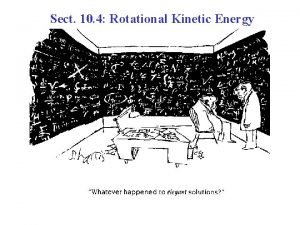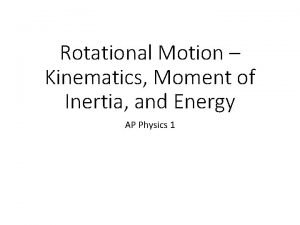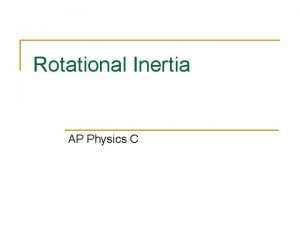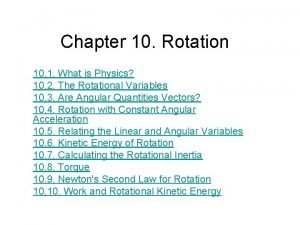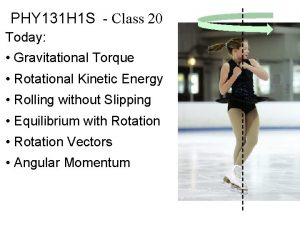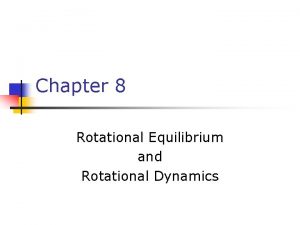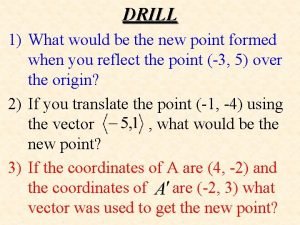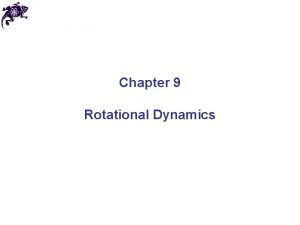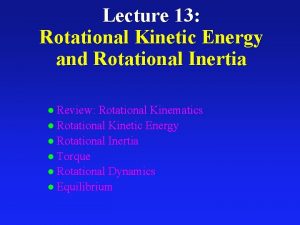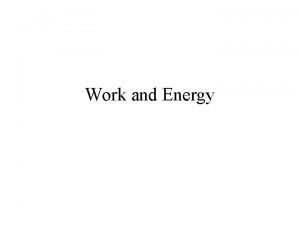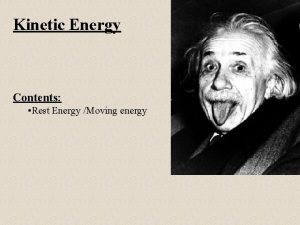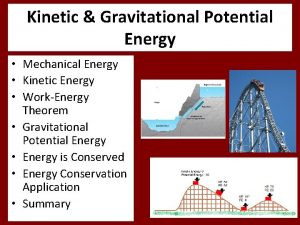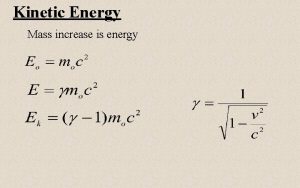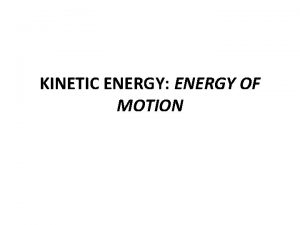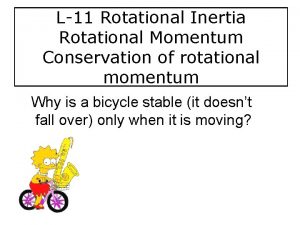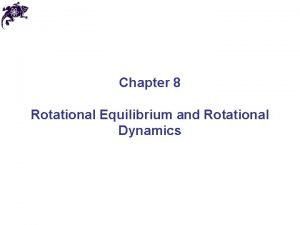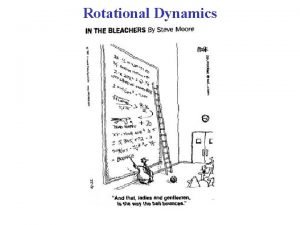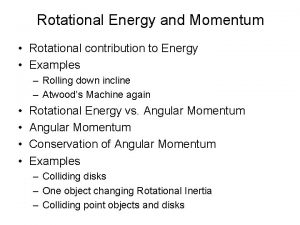Rotational Kinetic Energy Which would have a greater

























- Slides: 25

Rotational Kinetic Energy Which would have a greater Rotational Kinetic Energy? Both scenarios have a total of 8 tennis balls, all with a mass m, being spun at a constant rotational speed of ω, in a circle by length of string R. A. D. Can’t be determined B. C. Both the same

Rotational Kinetic Energy Ekr (J) When an object rotates it has Ekr. Objects can have both linear & rotational kinetic energy Ek of linear motion(center-of-mass) Ekr due to rotation Assuming conservation of Mechanical energy holds, then: d θ°

See weebly for animations http: //wsapphysics. weebly. com/rotational-inertia-e--p. html

Like a Rolling Disk E#1 A 1. 20 kg disk with a radius 0 f 10. 0 cm rolls without slipping. The linear speed of the disk is v = 1. 41 m/s. (a) Find the translational kinetic energy. (b) Find the rotational kinetic energy. (c) Find the total kinetic energy.

Check for Understanding

8. 4 Check for Understanding

Rolling Race (Hoop vs Cylinder) A hoop and a cylinder of equal mass roll down a ramp with height h. Which has greatest KE at bottom? A) Hoop B) Same C) Cylinder 20% 50% 30% I = MR 2 I = ½ MR 2

Rolling Down an Incline 0 0

The ring and biscuit wheels have identical mass and radius. Both ramps are identical. Both wheels are released at the same time. E#2 Which wheel will reach the bottom of the slope first? Explain your answer Biscuit wheel will reach the bottom of the slope first. ring biscuit • The inertia of the ring wheel is more that of the inertia of the biscuit wheel so the ring wheel is harder to get started. • The biscuit wheel having a lower inertia is easier to accelerate. • Since the biscuit has less rotational inertia then it will also have less Rotational Kinetic Energy at the bottom of the hill compared to the ring (Krot=1/2 Iw 2) • Since the biscuit has less Krot it has more K – since both start with the same Ug and Ug = K + Krot.

Compare Heights A ball is released from rest on a noslip surface, as shown. After reaching the lowest point, it begins to rise again on a frictionless surface. When the ball reaches its maximum height on the frictionless surface, it is higher, lower, or the same height as its release point? The ball is not spinning when released, but will be spinning when it reaches maximum height on the other side, so less of its energy will be in the form of gravitational potential energy. Therefore, it will reach a lower height.



A truck wheel has a mass of 65 kg and a radius of 0. 56 m. It is rolling down a 2. 0 m high slope. The truck wheel gains 540 J of rotational energy by the time it reaches the bottom of the slope. 1. Show the wheel's translational velocity at the bottom of the slope is 4. 8 m s-1. 2. Show the wheels angular velocity is 8. 6 s-1 at the bottom of the slope. 3. Calculate the rotational inertia of the truck wheel. E#3 2 m

1. Show the wheel's translational velocity at the bottom of the slope is 4. 8 ms -1.

2. Show the wheels angular velocity is 8. 6 s-1. 3. Calculate the rotational inertia of the truck wheel.

Say Galileo tested his free fall theory by rolling different diameter solid spheres down a slope, instead of dropping them off a ledge. Prove that his free fall theory is correct. Assume all spheres must be the same, i. e. solid and round. Galileo Galilei


Spinning Wheel A block of mass m is attached to a string that is wrapped around the circumference of a wheel of radius R and moment of inertia I, initially rotating with angular velocity w that causes the block to rise with speed v. The wheel rotates freely about its axis and the string does not slip. To what height h does the block rise? E#4

A Bowling Ball A bowling ball that has an 11 cm radius and a 7. 2 kg mass is rolling without slipping at 2. 0 m/s on a horizontal ball return. It continues to roll without slipping up a hill to a height h before momentarily coming to rest and then rolling back down the hill. Model the bowling ball as a uniform sphere and calculate h. E#5

Betty-Sue and Bubba decide to roll different objects down a long sloping, smooth driveway. The driveway can be treated as a ramp (see animation) and it has a 15 degree angle to the horizontal. Their 1 st object is a ball of 438 grams and a diameter of 19. 5 cm that rolls from rest 5. 9 m along the driveway. (a) Calculate the angular displacement of the ball as it rolls down the ramp. radius = = 0. 0975 m = 60. 512… ≈ 61 rad (2 SF) 5. 9 m Applet link 15° E#6

(b) The ball takes 3. 19 s to reach the bottom of the driveway. Calculate the final angular velocity and the angular acceleration of the ball.

(c) Calculate the rotational kinetic energy of the ball at the base of the ramp. (hint: use other energies to find your answer)

(d) What assumption(s) did you make in answering the previous question? Assumption: that all of the gravitational potential energy at the top of the hill was converted to linear kinetic and rotational kinetic energies at the base of the drive. Or: no energy was “lost” to heat or sound as the ball rolled down the drive.

(e) Calculate the rotational inertia of the ball. (f) Calculate the angular momentum of the ball at the base of the ramp.

(g) Later, Bubba lets 2 different masses go at the same time. He chooses a disk and a ring of the same mass and radius. Explain which reaches the bottom of the ramp first and why. • The disk will reach the bottom before the ring. • Since they have the same mass but different mass distribution, they have different rotational inertias while having the same total energy (E P at the top of the hill). • The ring has a larger rotational inertia, I, than the disk, since more of its mass is farther from the centre. • Thus the ring will have a larger portion of its original gravitational potential energy converted into rotational kinetic energy than the disk. • This leaves a small portion of energy for linear kinetic, thus a smaller linear speed for the ring.
 Moment of inertia of rod
Moment of inertia of rod Kinetic rotational energy formula
Kinetic rotational energy formula Rotational inertia ap physics c
Rotational inertia ap physics c A tall cylindrical chimney falls over
A tall cylindrical chimney falls over Rotational kinetic energy
Rotational kinetic energy Rotational equilibrium and dynamics
Rotational equilibrium and dynamics Rotational equilibrium and rotational dynamics
Rotational equilibrium and rotational dynamics Would like would rather
Would like would rather Would like would prefer would rather
Would like would prefer would rather Potential energy in spring
Potential energy in spring Kinetic energy in gravitation
Kinetic energy in gravitation Gravitational potential energy vs kinetic energy
Gravitational potential energy vs kinetic energy Mass and thermal energy
Mass and thermal energy The law of conservation of energy states that
The law of conservation of energy states that What is potential energy
What is potential energy Potential energy of spring
Potential energy of spring Potential energy
Potential energy Formula of potential energy
Formula of potential energy If susan had taken the map she . . .(not get) lost
If susan had taken the map she . . .(not get) lost Which statement best compares momentum and kinetic energy?
Which statement best compares momentum and kinetic energy? Which 3-d shape has 9 planes of symmetry?
Which 3-d shape has 9 planes of symmetry? 6 faces; 12 edges; 8 vertices
6 faces; 12 edges; 8 vertices Energy energy transfer and general energy analysis
Energy energy transfer and general energy analysis Energy energy transfer and general energy analysis
Energy energy transfer and general energy analysis Which image has reflectional rotational and point symmetry
Which image has reflectional rotational and point symmetry Armed services vocational aptitude battery definition
Armed services vocational aptitude battery definition
